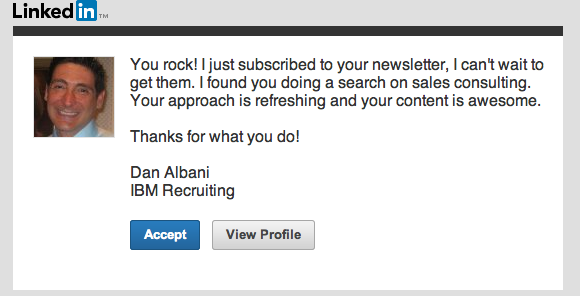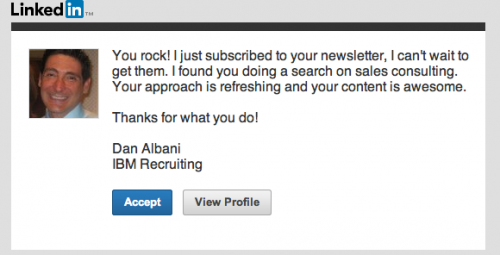I get tons of LinkedIn requests every day. I’m not a LION, but I do try to accept most request from everyone who asks. That being said, I have 100’s of unaccepted requests in my LinkedIn box. I haven’t accepted them yet because I don’t know them, why they wanted to connect and I can’t find any common ground.
I get a shit ton of connection requests because of this blog. I get that. I also make it easy to connect with me on LinkedIn. I’ve put that nifty little LinkedIn icon under my name where it says Keenan 411, on my business cards and everywhere else I put my name or presence. I’m OK with the volume of requests. It’s the laziness that drives me crazy. When people do try to connect, Few take the time to tell me why they want to connect or even how they fond me. They just click the box that delivers this message:
I’d like to connect with you on LinkedIn.
It drives me crazy. Who are you? Why do you want to connect with me? How did you find me? Do I know you? Do you read my blog? Are you a freak? WTF, gimme more than “I’d like to connect with you on LinkedIn.” I don’t have to know everyone I connect with on Linkedin. But, man at least take two seconds and introduce yourself before you ask me to get into your Linkedin bed. I’m not a total social media whore. 🙂
If you’re going to take the time and ask someone to connect with you on LinkedIn and you don’t already know them, then you need to create a personal message, period. It’s just too lazy and in effective not to.
I got this killer request this morning. It took me less than 1 minute to accept his request AND send him a personal note back. He earned it.
LinkedIn is a critical tool in sales. It can get you access to more people than ever before. Like most things however, you can’t be a hack. Just chucking out connection requests with out an introduction or explanation of why you want to connect is being a hack.
The best way to connect on LinkedIn, for sales people, if you don’t know the person is to do anyone of the following;
Give them a reason: Just because you want to connect with someone doesn’t mean they want to connect with you. Sending a generic connection request doesn’t give the other person any reason (AT ALL) to accept. You are offering NOTHING in return. They don’t know you. They don’t know what value you possess. They don’t know why they should bother accepting a request from a random. Give someone a reason to connect with you. Let them know why there is value in connecting with you.
Create a connection: Spend some time upfront identifying or creating a connection with the person you want to be connected with. Find some common ground between the two of you, a group, an industry, common problems, etc. Coming in out of the blue with no inherent connection isn’t going to compel someone to click “connect.” Find a way to connect with them before you ask to connect.
Don’t ask for something: What ever you do, don’t ask for something in the connection request. Can you imagine being at a party and walking up to someone and asking them for something before you even go through the formality of introductions? Yeah I know, right? Well, asking for something in a connection invite is the same thing. Build rapport, create a connection and bring value. There will be time later for the “ask.”
Take your time: Once you’re ready to reach out, take your time. Treat the invite like an email, which it is. It’s delivered to the recipients email inbox. You would never send a one sentence email to a stranger, so why use LinkedIn to send a one sentence email, duh? Craft a compelling invite request that includes, why you’re asking to connect, what they get for connecting and a close. It’s that simple. LinkedIn limits the number of characters you can use, so don’t worry about getting wordy. You’ll be stopped.
LinkedIn is a great tool for selling and building your network. But, like any other tool, the value is in learning to master it. Don’t be a hack. When it comes to asking to connect take your time, be deliberate and give something back. It’s just like the real world, no matter how much we try to pretend it’s not.


